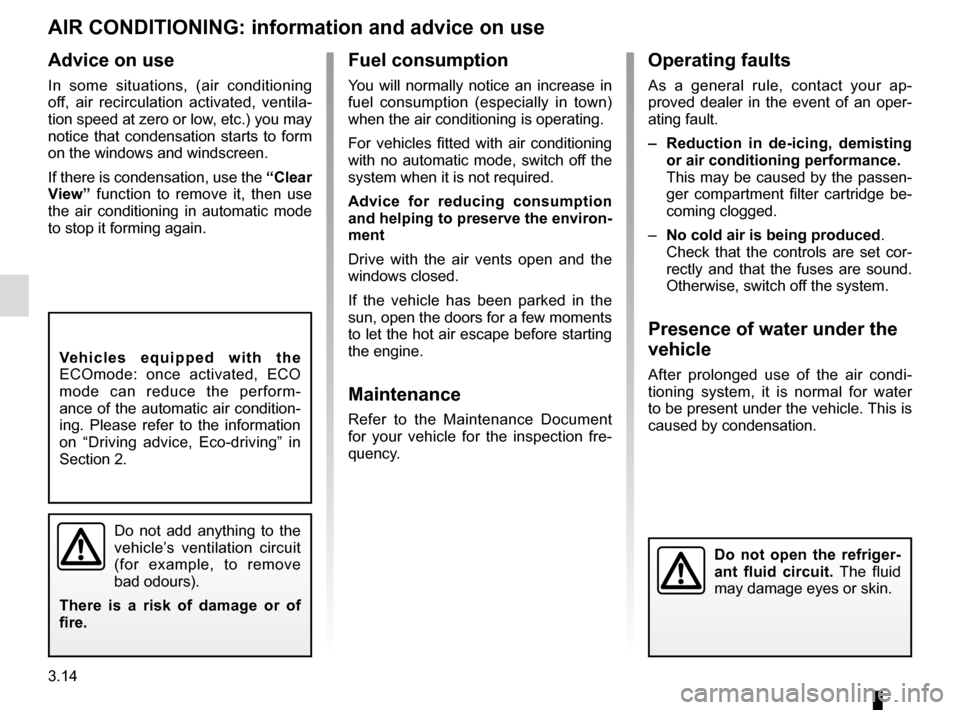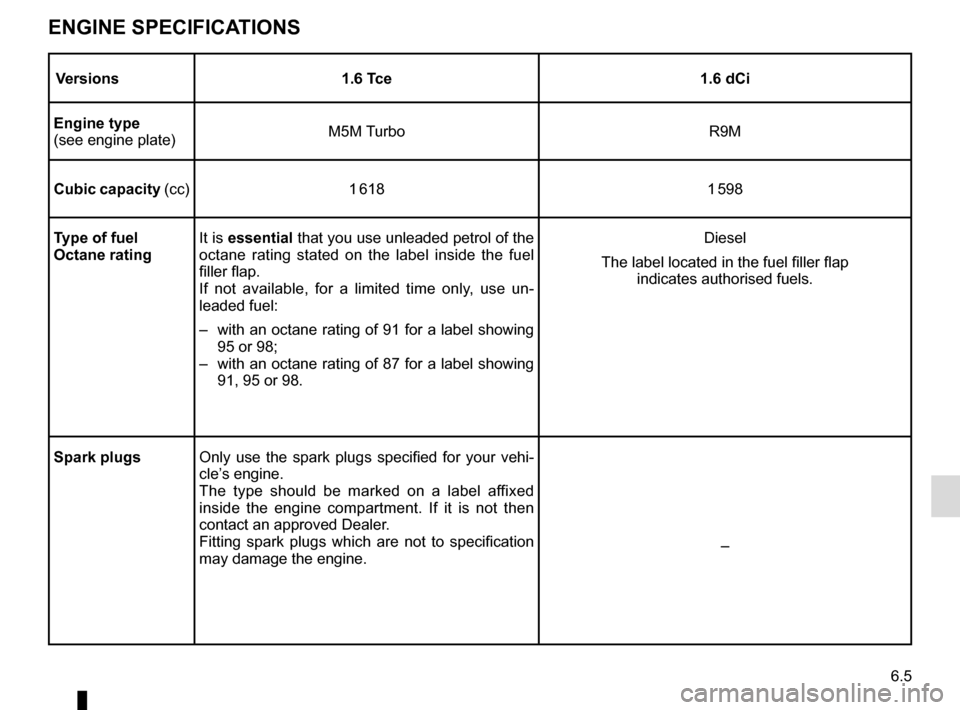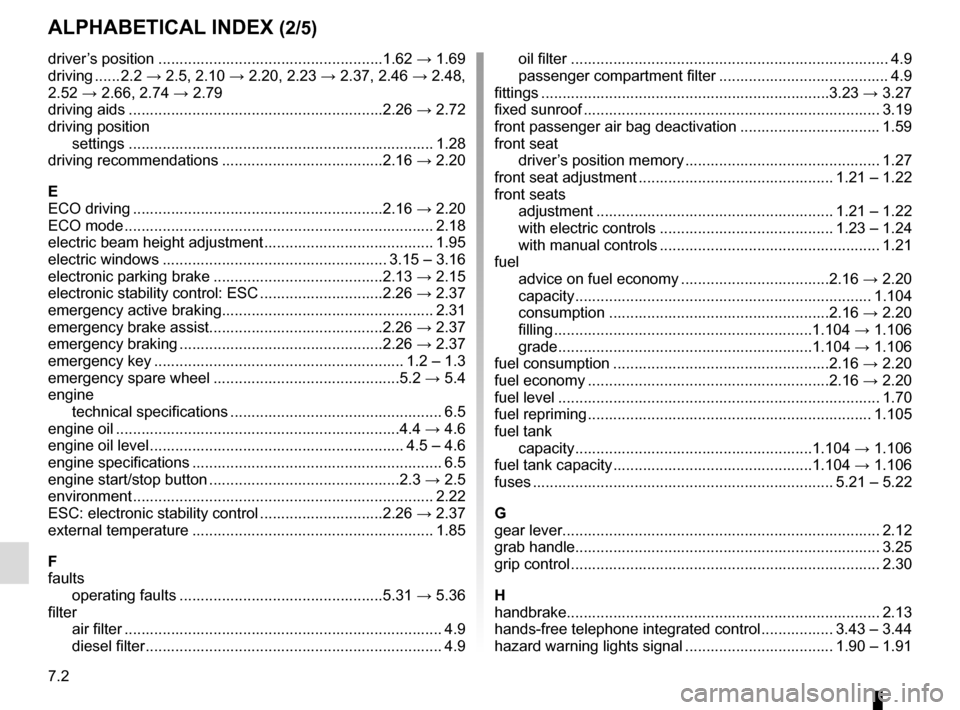2015 RENAULT ESPACE fuel cap
[x] Cancel search: fuel capPage 110 of 316

1.104
FUEL TANK (1/3)
Useable fuel tank capacity:
approx. 58 litres.
With the vehicle unlocked, to open
cover 1, press area A then release. The
cover 1 opens.
Valve 2 is integrated into the filler pipe.
For details on filling the fuel tank, refer
to the information on “Filling with fuel”.
To close it, press on the fuel filler flap by
hand, as far as it will go.Fuel grade
Use a high-grade fuel that complies
with the legislation in force in each
country and which must comply with
the specifications given on the label
on the cover 1 . Please refer to the in-
formation on “Engine specifications” in
Section 6.
Never press valve 2 with
your fingers.
Do not wash the filler
area with a high-pressure
washer.
Do not mix even small
amounts of petrol (un-
leaded or E85) with diesel.
Do not use ethanol-based
fuel if your vehicle is not compatible
with this fuel.
Do not add additive to the fuel –
otherwise you risk damaging the
engine.
Diesel versions
Only use diesel fuel which complies
with the information on the label located
inside the cover 1.
Petrol versions
It is essential to use unleaded petrol.
The octane rating (RON) must comply
with the information given on the label
on the cover 1. Refer to Section 6 for
information on “Engine specifications”.
1
A
21
Page 132 of 316

2.20
DRIVING ADVICE, ECO-DRIVING (5/5)
Advice on use
– Favour the ECO mode.
– Electricity is fuel; switch off all the electrical components which are
not really needed. However (safety
first), keep your lights on when the
visibility is bad (“see and be seen”).
– Use the air vents. Driving with the windows open at 60 mph (100 km/h)
will increase fuel consumption by
4%.
– Never fill the fuel tank right to the brim to avoid overflow.
– In vehicles fitted with air conditio-
ning, it is normal to observe an in-
crease in fuel consumption (espe-
cially in urban conditions) when it is
used. For vehicles fitted with manual
air conditioning, switch off the system
when it is not required.
Recommendations for reducing
consumption and therefore help-
ing to preserve the environment:
If the vehicle has been parked in the
sun, open the doors for a few mo-
ments to let the hot air escape before
starting the engine.
– Do not leave an empty roof rack fitted to the vehicle.
– It is better to fit a trailer for bulky ob- jects.
– When towing a caravan, fit a wind deflector and adjust it carefully.
– Avoid using the car for door-to-door calls (short journeys with long waits
in between) because the engine
never reaches its normal operating
temperature.
Tyres
– An underinflated tyre increases fuel consumption.
– Opt for the highest speed pressure or the pressure recommended to op-
timise fuel consumption indicated
on edge of the driver’s door (please
refer to the information on “Tyre infla-
tion pressure” in Section 4).
– The use of non-recommended tyres can increase fuel consumption.
Page 206 of 316

3.14
AIR CONDITIONING: information and advice on use
Do not add anything to the
vehicle’s ventilation circuit
(for example, to remove
bad odours).
There is a risk of damage or of
fire.
Do not open the refriger-
ant fluid circuit. The fluid
may damage eyes or skin.
Fuel consumption
You will normally notice an increase in
fuel consumption (especially in town)
when the air conditioning is operating.
For vehicles fitted with air conditioning
with no automatic mode, switch off the
system when it is not required.
Advice for reducing consumption
and helping to preserve the environ-
ment
Drive with the air vents open and the
windows closed.
If the vehicle has been parked in the
sun, open the doors for a few moments
to let the hot air escape before starting
the engine.
Maintenance
Refer to the Maintenance Document
for your vehicle for the inspection fre-
quency.
Operating faults
As a general rule, contact your ap-
proved dealer in the event of an oper-
ating fault.
– Reduction in de-icing, demisting or air conditioning performance.
This may be caused by the passen-
ger compartment filter cartridge be-
coming clogged.
– No cold air is being produced .
Check that the controls are set cor-
rectly and that the fuses are sound.
Otherwise, switch off the system.
Presence of water under the
vehicle
After prolonged use of the air condi-
tioning system, it is normal for water
to be present under the vehicle. This is
caused by condensation.
Advice on use
In some situations, (air conditioning
off, air recirculation activated, ventila-
tion speed at zero or low, etc.) you may
notice that condensation starts to form
on the windows and windscreen.
If there is condensation, use the “Clear
View” function to remove it, then use
the air conditioning in automatic mode
to stop it forming again.
Vehicles equipped with the
ECOmode: once activated, ECO
mode can reduce the perform-
ance of the automatic air condition-
ing. Please refer to the information
on “Driving advice, Eco-driving” in
Section 2.
Page 295 of 316

6.5
ENGINE SPECIFICATIONS
Versions1.6 Tce 1.6 dCi
Engine type
(see engine plate) M5M Turbo
R9M
Cubic capacity (cc) 1 618 1 598
Type of fuel
Octane rating It is
essential that you use unleaded petrol of the
octane rating stated on the label inside the fuel
filler flap.
If not available, for a limited time only, use un-
leaded fuel:
– with an octane rating of 91 for a label showing 95 or 98;
– with an octane rating of 87 for a label showing 91, 95 or 98. Diesel
The label located in the fuel filler flap indicates authorised fuels.
Spark plugs Only use the spark plugs specified for your vehi-
cle’s engine.
The type should be marked on a label affixed
inside the engine compartment. If it is not then
contact an approved Dealer.
Fitting spark plugs which are not to specification
may damage the engine. –
Page 310 of 316

7.2
ALPHABETICAL INDEX (2/5)
driver’s position .....................................................1.62 → 1.69
driving ...... 2.2 → 2.5, 2.10 → 2.20, 2.23 → 2.37, 2.46 → 2.48,
2.52 → 2.66, 2.74 → 2.79
driving aids ............................................................2.26 → 2.72
driving position settings ...............................................................\
......... 1.28
driving recommendations ......................................2.16 → 2.20
E
ECO driving ...........................................................2.16 → 2.20
ECO mode ........................................................................\
. 2.18
electric beam height adjustment ........................................ 1.95
electric windows ..................................................... 3.15 – 3.16
electronic parking brake ........................................2.13 → 2.15
electronic stability control: ESC .............................2.26 → 2.37
emergency active braking................................................\
.. 2.31
emergency brake assist.........................................2.26 → 2.37
emergency braking ................................................2.26 → 2.37
emergency key ........................................................... 1.2 – 1.3
emergency spare wheel ............................................5.2 → 5.4
engine technical specifications .................................................. 6.5
engine oil ...................................................................4.4 → 4.6
engine oil level ............................................................ 4.5 – 4.6
engine specifications ........................................................... 6.5
engine start/stop button .............................................2.3 → 2.5
environment ............................................................\
........... 2.22
ESC: electronic stability control .............................2.26 → 2.37
external temperature ......................................................... 1.85
F
faults operating faults ................................................5.31 → 5.36
filter air filter ........................................................................\
... 4.9
diesel filter ...................................................................... 4.9 oil filter ........................................................................\
... 4.9
passenger compartment filter ........................................ 4.9
fittings ...............................................................\
.....3.23 → 3.27
fixed sunroof ...................................................................... 3.19
front passenger air bag deactivation ................................. 1.59
front seat driver’s position memory .............................................. 1.27
front seat adjustment .............................................. 1.21 – 1.22
front seats adjustment ........................................................ 1.21 – 1.22
with electric controls ......................................... 1.23 – 1.24
with manual controls .................................................... 1.21
fuel advice on fuel economy ...................................2.16 → 2.20
capacity ...............................................................\
....... 1.104
consumption ....................................................2.16 → 2.20
filling .............................................................1.1\
04 → 1.106
grade ............................................................1.104 \
→ 1.106
fuel consumption ...................................................2.16 → 2.20
fuel economy .........................................................2.16 → 2.20
fuel level ........................................................................\
.... 1.70
fuel repriming ................................................................... 1.105
fuel tank capacity ........................................................1.104 → 1.106
fuel tank capacity ...............................................1.104 → 1.106
fuses ....................................................................... 5.21 – 5.22
G
gear lever..............................................................\
............. 2.12
grab handle.............................................................\
........... 3.25
grip control ........................................................................\
.
2.30
H
handbrake...............................................................\
........... 2.13
hands-free telephone integrated control ................. 3.43 – 3.44
hazard warning lights signal ................................... 1.90 – 1.91